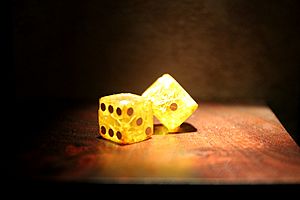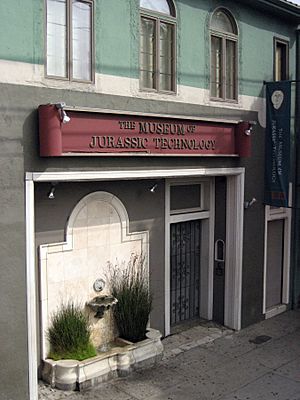Museum of Jurassic Technology facts for kids
The Museum of Jurassic Technology is a very special museum located in Los Angeles, California. It was started in 1988 by David Hildebrand Wilson and Diana Drake Wilson. Even though its name mentions "Jurassic Technology," the museum doesn't actually focus on dinosaurs or ancient tools. Instead, it's a unique place that mixes art, science, history, and even some mysterious items. It's a bit like the old "cabinets of curiosities" that people collected long ago, which were early versions of museums.
Many of the exhibits at the museum are quite unusual, and it's sometimes hard to tell what's real and what's part of the museum's creative storytelling. David Hildebrand Wilson even received a special award called a MacArthur Fellowship in 2001 for his work. On July 8, 2025, a small fire happened at the museum, which caused some smoke damage to a few exhibits.

Contents
What Makes This Museum Special?
The Museum of Jurassic Technology is known for being very different from other museums. A writer for The New York Times once called it a "museum about museums." This means it makes you think about what a museum is supposed to be. Smithsonian magazine described it as a clever tribute to old private museums. In those days, science was still new, and museums were more like collections of strange and wonderful things.
A book called Mr. Wilson's Cabinet of Wonder by Lawrence Weschler tries to explain the museum's mysteries. Weschler talked a lot with the museum's founder, David Wilson, and researched many of the exhibits. He found that some exhibits seemed to be from Wilson's imagination, while others could fit into a regular history museum. David Wilson says his museum shows things that other natural history museums might not want to display.
The museum's introduction explains that the word "museum" originally meant "a place for the Muses." The Muses were goddesses of art and science. This idea means a museum should be a place where your mind can think deeply, away from everyday worries. The museum's dim lights, old-fashioned display cases, and winding paths help visitors explore many topics. These include art, nature, the history of science, and different ways of gaining knowledge. About 25,000 people visit the museum each year.
Exploring the Exhibits
The museum has more than 30 permanent exhibits. Here are some of the most interesting ones:
Stories of Memory and Forgetting
- The Delani/Sonnabend Halls: This exhibit tells the story of an opera singer named Madalena Delani and a thinker named Geoffrey Sonnabend. Sonnabend believed that memory is something we create to protect ourselves from the sad truth that time passes and moments are lost forever. He thought there is only experience and then its fading away.
Unusual Collections and Cures
- Tell the Bees: Belief, Knowledge, and Hypersymbolic Cognition: This display shows old cures and remedies from before modern science.
- The Garden of Eden on Wheels: This exhibit features collections from trailer parks in the Los Angeles area.
Tiny Worlds and Hidden Art
- The Unique World of Microminiatures of Hagop Sandaldjian: This amazing collection features tiny sculptures carved from a single human hair. Each one is placed inside the eye of a needle. You can see figures like Goofy, Pope John Paul II, and Napoleon I. Other tiny artworks include violins, dancers, a crucifix made from the artist's own hair and gold, and cartoon characters like Donald Duck and Pinocchio.
- Micromosaics of Harold "Henry" Dalton: These are tiny mosaics from the 1800s that show flowers, animals, and other objects. They are made entirely from tiny butterfly wing scales and diatoms (tiny algae).
Science, Art, and History
- The Stereofloral Radiographs of Albert G. Richards: This exhibit displays special X-ray images of flowers that create a 3D effect.
- Rotten Luck: The Decaying Dice of Ricky Jay: This collection features old, decaying dice that once belonged to the famous magician Ricky Jay.
- No One May Ever Have the Same Knowledge Again: Letters to Mt. Wilson Observatory: This small room shows unusual letters and theories sent to the Mount Wilson Observatory between 1915 and 1935.
- The World is Bound with Secret Knots: The Life and Works of Athanasius Kircher: This exhibit explores the many interests and inventions of Athanasius Kircher, a 17th-century scholar who founded a museum in Rome.
- The Lives of Perfect Creatures: The Dogs of the Soviet Space Program: This is a gallery of oil paintings showing the brave dogs who were part of the Soviet space program.
- Fairly Safely Venture: String Figures from Many Lands and their Venerable Collectors: This exhibit showcases different string figures (like cat's cradle) from around the world.
Other Museum Features
In 2005, the museum opened its Tula Tea Room. This is a Russian-style tea room where visitors can enjoy Georgian tea and cookies, which are included in the admission price. The room is a small copy of Tsar Nicolas II's study from the Winter Palace in St. Petersburg, Russia. Live doves and other birds also share this peaceful room.
The Borzoi Kabinet Theater shows a series of poetic documentaries. These films are made by the Museum of Jurassic Technology with a group from St. Petersburg called Kabinet. The film series is called A Chain of Flowers. This name comes from a quote by Charles Willson Peale, who said that learners should be guided "along, as it were, a chain of flowers into the mysteries of life." The films include Levsha: The Cross-eyed Lefty from Tula and the Steel Flea (2001), Obshee Delo: The Common Task (2005), Bol'shoe Sovietskaia Zatmenie: The Great Soviet Eclipse (2008), The Book of Wisdom and Lies (2011), and Language of the Birds (2012).



